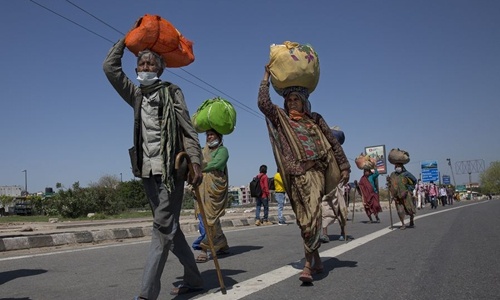If there is one image from the coronavirus pandemic days that will forever remain etched in our memories, it will be that of thousands of migrant workers taking arduous journeys back home amid meagre food, water and monetary resources.
This image of struggling migrant workers will remain etched in our memories for the intensity of pain that it evokes, the breakdown of the state apparatus that it indicates and the uncountable dreams and aspirations that it finds scattered before its very eyes.
It is as much a powerful image as it is a disturbing and deeply penetrating one. There is no doubt that the coronavirus pandemic and the associated lockdown have caused unprecedented economic losses for the country and its migrant workers are among a section of the population which has been most severely affected by it.
With widespread loss of livelihoods and jobs and meagre savings that were already exhausted in the first couple of days of the lockdown, the last couple of weeks have been nothing less than a thoroughly devastating experience for most Indian migrant workers.
According to the Centre for Monitoring Indian Economy(CMIE),it has been estimated that more than 122 million people have lost their jobs in the month of April alone and 3/4 of these were composed of small traders and wage earners.
Crisis of the Migrant Worker: A Major Portion of the Problem
There is no doubt about the fact that the crisis in which migrant workers find themselves is unprecedented in more ways than one and it points towards a greater existential crisis for India’s poor and struggling population.
The crisis of the migrant workers forms the major component of the looming crisis and there is no way in which we can choose to ignore it. While earlier government responses seemed to have little potential of offering comfort to the migrant workers, the government seems to have now woken up to some degree to the extensive human tragedy.
It has recently announced a Rs 3,500 crore food support programme for migrants. But how will the government ensure that such a scheme is not just confined to papers and reaches out to the affected population? The government has been obsessed with establishing identity and registrations through extensive paperwork and has made it a criteria for the beneficiaries of most schemes, but how will the government make sure that the benefits reach the migrant class, which in most cases lacks the essential documentations?
Another important challenge that faces any policy related decision as far as migrant workers amid the pandemic is concerned is associated with the lack of critical data on the circulation of migrant workers, about how they are recruited and what are the challenges that they are exactly faced with during an economic emergency, such as the coronavirus associated lockdown?
Over the years, the governments have been able to do little to develop some sort of systematic understanding of the existence of migrant workers and the extent of the migrant exodus. This crisis, must compel the government to specify its process of collecting data and worlds closely with the stakeholders who work on issues of the migrant and labouring class.
Will the Distressed Migrant Worker Return Back?
One of the most important challenges that the pandemic has unleashed and brought to the table is regarding the absence of social safety for migrant workers. It is clear that the migrant workers in India have little or no safety fallback and that it seems unlikely that migrants who used to travel from one state to another for work, will want to come back unless they are guaranteed some protection.
A large number of major sub-sectors use migrant workers to a great degree and these include textiles, stone quarries, construction, mines, brick kilns, small-scale industries, crop transplanting, sugarcane cutting, rickshaw pulling and street vending, fisheries, domestic worker, security services, sex work, small holes and restaurants among a host of other activities.It is estimated that the economic contributions made by migrant workers to the Indian economy is nothing short of 10% of India’s gross domestic product(GDP).
Internal migrants compose the greater portion of this labour force, highlighting the reality that people are forced to migrate from one state to another to support their families and allow for direct money flow to their families. Yes, the poorest of the poor looks at inter-state migration as the only option to sustain amid lack of skills, low literacy levels and extremely disadvantaged economic backgrounds.
It is ironic that despite having such an overwhelming presence in India’s workforce, migrant workers are largely undocumented and data on movement intricacies continues to be missing.
This is a shocking state of affairs in a country that runs on the work of migrant workers. But isn’t this only a symptom of a greater underlying disease, that negates the presence of the poor and marginalised sections of the population and does not even care to collate and collect data on the section?
Will the lessons that we have learnt on the inadequacy of data on the migrant class equip us to move with a more well-planned post COVID-19 strategy?
What are the Conditions Under Which a Migrant Worker Toils and Labours?
The life conditions of the average migrant worker is marked with extreme poverty and helplessness. The working conditions in which they are compelled to work, especially in the unorganised sector see them amidst extreme exploitation and even hazards. The conditions in which migrant workers find themselves in terms of both life and livelihood show us their relative disadvantage, generational neglect and continued ignorance and marginalisation in the hands of the state.
They find themselves in indecent/inhuman work conditions, often exposing their lives to risk and a compulsion of poverty that doesn’t allow them to resist or break free from the oppressive shackle.
What adds to their pathetic plight is the fact that in a large number of sub-sectors, formal contracts don’t exist and the working and living conditions of the migrant workers are largely determined by the contractors.
With years of state neglect and lack of policy outreach, these migrant workers know that there is no protective hand above them.
Owing to extreme poverty and illiteracy, in most cases migrant workers are unaware of their rights and are seldom able to organise themselves fruitfully for political mobilisation. A large section of India’s migrant workers who get employment in its mega cities come from states like Uttar Pradesh, Madhya Pradesh and Bihar, while states like Gujarat, Delhi and Haryana absorb most of them.
But despite the fact that an overarching trend can be seen in the patterns of internal migration, it is still very difficult to establish any type of trend as far as the inter-state migration of migrant workers owing mainly to the complex sub-contracting practices and placement by recruitment agents, where migrants are seldom documented for in the books of the employers. Data on women migrant workers is also extremely weak because they find themselves in less visible forms of work or occupations.
The Need for Understanding Exclusionary Practices Against Migrants
There is an urgent need to strengthen our understanding of the exploitation and vulnerability that migrant working men and women and their children face. Their lived experiences of exclusion/marginalisation and the reasons why they are compelled to migrate, all throw important light on the pains and traumatic situation that migrant workers find themselves. If such data is collated, it will help inform policy building in a more informed fashion. While we have a plethora of rich ethnographic research on important issues around the lives of the migrant class, but there is an urgent need to collate data and statistics on the migrant class and issues that surround their life. If this data is collected and combined it will inform policy decisions and guide governmental actions in a much better way.
In conclusion there is an urgent need to recognise and acknowledge the gravity of the migrant crisis and draw on the critical lessons that we have learnt about them amid the lockdown. This alone will help us build a sound and effective post lockdown strategy.














